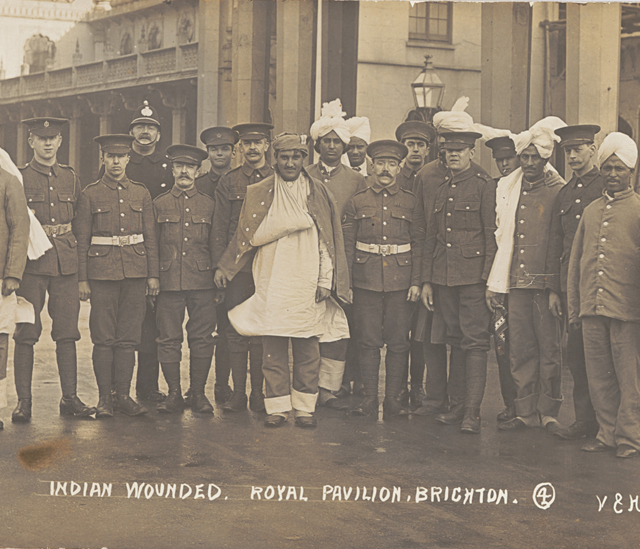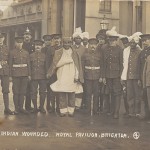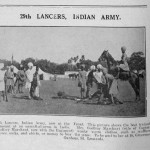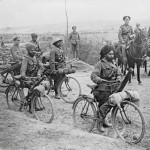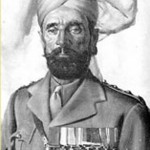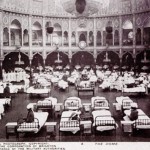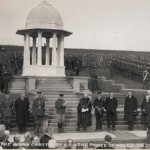The following information is for teachers to utilise in planning classroom activities.
When war was declared in 1914, Britain relied heavily on soldiers from the empire. Men from around the world would arrive in East Sussex to fight for Britain.
At the outbreak of the First World War, the Indian Army numbered 240,000 men; by 1918 it had grown to nearly 550,000. Most recruits came from the north of India, especially the Punjab. The Indian army at the time was made up of numerous religions. Battalions of Punjabi Muslims served in Mesopotamia and, after the war, the 92nd Battalion were made ‘Prince of Wales’s Own‘ in recognition of their bravery and gallantry. Sikhs made up 20% of the British Indian Army at the outbreak of the war. By its conclusion around 130,000 Sikh soldiers had served.
Indian soldiers served on many battlefields over the course of the war but many of the troops were unfamiliar with their equipment, having only been assigned their rifles and kit upon arriving in France. Their lack of warm clothing during the cold weather soon saw morale plummet and desertion was not uncommon. In October 1915, the infantry divisions were withdrawn to Egypt whilst the cavalry remained in France.
Nearly 700,000 Indian soldiers served in Mesopotamia (modern day Iraq) fighting against the Ottoman Empire. Indian soldiers also fought the Germans in East Africa and defended the Suez Canal. Three battalions of Gurkhas and one of Sikhs participated in the Gallipoli campaign. The Sikh Battalion was almost wiped out in the Battle of Krithia.
Smaller units of Indian soldiers also served in Singapore and China, whilst many others remained in India to defend the North Western border against incursions from Afghanistan.
During the First Battle of Ypres, Khudadad Khan, used his machine gun position to hold the allied line and prevent a final German breakthrough. When the position was finally overrun, the defenders were all killed, except for Khan who suffered many wounds and was left for dead. Despite his injuries he managed to crawl back to his own lines under cover of darkness. He and his men had held the line long enough for further reinforcements to arrive. For his courage and bravery Khan was awarded the Victoria Cross.
Many Indian soldiers like Khudadad Khan were wounded during the war and a great number of them were taken to Brighton to be nursed back to health. The Royal Pavilion, Corn Exchange and Dome were all converted into military hospitals and provided 722 beds. The workhouse on Elm Grove was renamed the Kitchener Hospital and also took in patients. Between 1914 and 1916, 12,000 soldiers were treated in Brighton with 4,306 placed in the Pavilion. Only 32 men died in the Royal Pavilion hospital.
As these soldiers were a mix of Muslims, Hindus and Sikhs, great care was taken to respect the religion and customs of each. Separate water supplies were provided for Hindus and Muslims in each ward, and nine kitchens catered for the different requirements of the patients. Separate areas were also provided for worship with a marquee being erected in the grounds for Sikhs and an east-facing area of the lawn reserved for Muslim prayer. Wounded soldiers were cared for by orderlies of the same caste and religion.
However, at times, the patients at the Royal Pavilion were also kept apart from the inhabitants around them. Barbed wire was placed around the Pavilion in order to keep the patients in and the residents of Brighton out. The army was particularly concerned about the possibility of the female inhabitants of Brighton contracting a bout of ‘Khaki Fever‘.
By the end of 1915, the Indian Army was moved away from the Western Front to Mesopotamia and no further Indian soldiers arrived in Brighton.
Following the conclusion of the war, a permanent memorial was opened at Brighton Pavilion in honour of the Indian soldiers who had been cared for. The ‘India Gate‘ was opened in 1921 by the Maharaja of Patiala. In his speech he paid tribute to ‘Brighton’s abounding hospitality’.
To commemorate the Indian soldiers who had died in the various hospitals in Brighton, a permanent memorial was unveiled in the South Downs. The Chattri was unveiled by the Prince of Wales in 1921. The Royal British Legion held an annual pilgrimage to the memorial every year until 1999. Since 2000 the ceremony has been conducted by the Chattri Memorial Group and takes place every June.
Questions to ask your students
1) How big was the Indian Army by 1918?
2) What different religions did soldiers in the Indian Army have?
3) When did Indian soldiers leave Brighton?
Images
- Indian soldiers at the Royal Pavilion – The Royal Pavilion and Museums, Brighton & Hove
- The 29th Lancers, Indian Army. Hastings and St leonard Pictorial Advertiser.
- Indian soldiers on the Somme. Image courtesy of Brighton and Hove Black History
- Khudadad Khan VC. Image courtesy of Brighton and Hove Black History
- Brighton Dome as a hospital. Image courtesy of Brighton and Hove Black History
- Opening of the Chattri. Image courtesy of Brighton and Hove Black History
Click here to download a copy of this resource: First World War – Indian Soldiers – teachers

